EBR charges a service fee to manufacturers to produce ebike reviews and videos, this began in 2018. It’s the same flat fee for each bike, and it helps us to keep the site going while limiting ad clutter. We appreciate the opportunity to serve you with our opinions and data but respect your right to know that we receive compensation :)
iGO has been leader in the Canadian electric bike market since they launched in 2006. Their earliest models utilized a unique canister style mid-motor, designed to be efficient and balanced, that left something to be desired in terms of acceleration and noise. In recent years, as Bosch, Yamaha, Brose, and others have launched sophisticated mid-drives, iGO seems to have pivoted towards more affordable drive systems, using geared hub motors and rack mounted batteries that are less complex and less dynamic. What I saw and experienced with the Elite model is a refinement of that approach. The bike is priced incredibly well, given the hardware quality and two-year warranty. It’s a bicycle that is easy to approach, mount, and stand-over, for people with sensitive knees and hips, or those with short inseams. There’s only one frame size and color option, but it isn’t too masculine or feminine, and iGO has a range of other products that utilize the same motor and battery configuration, so you could mix it up that way if you wanted. In the early days, it was difficult to find iGO in the United States. This is a company that is striving to build a dealer network (with over 30 shops in the US and Canada today) but will ship direct. I spoke with the founder about territories and he explained that they will ship to customers free of charge and credit any local dealer, minus the cost of shipping. In this way, repairs and warranty service can be handled more efficiently. Ideally, you’d be able to find this product at a local dealer and test the fit, iGO Electric claims that it will accommodate riders ranging from five foot to six foot two inches in height. The seat tube goes very low, and the rack is positioned pretty far back, so you can lower the saddle without colliding. The tall seat post and adjustable-angle stem provide many options for taller riders, and I was able to get full leg extension for myself during the test rides. I’m five foot nine inches and weigh about 135 lbs. In the years between mid-motors and this latest generation with hub motors and downtube-mounted battery packs, there were some models with rear rack batteries. I liked these, but the frames suffered from a bit of flex and some of the rack hauling capacity was given up just to hold the pack (which could weigh upwards of nine pounds. In 2017, iGO had a very similar model to the Elite called the eXplore. It also had a lower step-thru wave frame, but utilized two downtubes vs. a single tube here. The engineering on this frame is very impressive. There’s a large metal gusset connecting the main tube to the seat tube, to reduce frame flex and support loads up to 250 lbs. All of the cables and wires are internally routed, so the bike looks clean, and the motor power cable is tucked away so it won’t get bent or snagged as easily. With this ebike, you get a blend of utility, efficiency, and cruiser style comfort. There are many comfort upgrades, safety enhancements, and two drive modes that allow you to ride slow and quiet, quick and responsive, or sit back and use a trigger throttle (which can be great for sensitive knees and those with limited mobility). Yes, I was very impressed with this electric bicycle and will dig into some of the details below, along with the pros and cons at the very end of the writeup.
The motor driving this bike is a planetary geared hub motor, designed by iGO and manufactured through a strategic partnership with a Chinese firm. Almost all bicycles and ebike components are produced in China, and iGO has been around long enough to have developed a really close relationship with one firm (I’m told). This allows them to tweak their products and really dial in performance vs. going with a generic part and compromising. The motor offers 500 watts of nominal power, peaking out around 650 watts. It produces over 43 Newton meters of torque (which is pretty good for a hub motor) and runs on 48 volts and an 18 amp controller. For comparison, many other ebikes in this price range utilize less powerful and less efficient 36 volt systems with 16 or 17 amp controllers. The motor freewheels efficiently, so you can pedal without turning the bike on and not experience drag. It’s also very quiet, especially in the first three levels of assist. I really appreciate how iGO specced the motor casing to be black, along with the spokes and rim. The rim does not have machined sidewalls (because the bike does not use caliper or v-brakes) and everything just blends together beautifully. The motor is sandwiched between an entry-level 8-speed cassette on the right with a Shimano Altus derailleur, and an entry-level Tektro Aries 180 mm mechanical disc brake rotor on the left. Compared to the older eXplore model, the larger 180 mm rotor will be easier to adjust and provide greater mechanical advantage over the large 700c (28-inch) wheelset. Both disc brakes are 180 mm, and the brake levers offer comfortable rubberized edges and an integrated bell. I love this bell… it stays out of the way, allowing the trigger throttle and display panel to be mounted closer to the grip, and it sounds beautiful. The benefit of using a hub motor vs. a mid-drive is that it does not interfere with the drivetrain, you do not have to shift gears in order to get more torque or reach higher speeds. They tend to work better with throttles and don’t require as much customization on the frame. The downside is that some weight is positioned towards the back of the bike and you cannot get as much efficiency by shifting gears, because the motor drives the rear wheel directly. Overall, I was very impressed with the motor design, power cable location, and performance on this electric bike. The rear hub spacing appeared to be 150 mm vs. a more common 135 mm, but perhaps they needed to widen it in order to fit the eight sprockets and disc brake? It felt solid during my ride tests, and the thicker 12 mm axle was secured with large silver nuts. I would recommend keeping an eye on the rear tire pressure to avoid flat tires (keep it between the recommended 50 and 85 PSI). The front wheel offers quick release, but the rear wheel is going to take more work and effort to service, even with the quick disconnect on the motor cable… and rear wheels tend to get flats more easily than front because of body weight and rack weight positioning.
The battery pack design used for this e-bike is from a company called Reention and is semi-integrated. That means, part of the pack is seated into the downtube, and part is exposed above. It doesn’t look as beautiful as a fully-integrated pack, but it’s allows the frame design to be lighter weight, less complex, and definitely less expensive. I mentioned that iGO sells a range of products, and some of their other bikes have higher capacity batteries that fit into the exact same case. That means, you could get two ebikes from them and swap the batteries for more range. Given the black accents on almost all of the tubing hardware and accessories on the Elite, the black battery casing blends in pretty well. It would be easy to kick and scratch each time you mount the bike, but the alloy casing just has silver underneath the black paint and it won’t rust. It’s tough, and it locks securely to the frame. The locking cylinder is positioned near the top, on the left side of the frame. It’s spring loaded, so you don’t have to manually turn the key to lock the pack after you seat it. You don’t even need to take the pack off of the bike to charge it, if you don’t want to. There’s a little circular charging port near the bottom of the battery, also on the left side. And I want to send a big thank-you and shout out to the Reention team for making the rubber cover for this port much easier to seat than some of the older designs. Given the position of this plug, I was a bit concerned about how close the left crank arm and pedal would come to the plug, which could snag and bend it. Just be careful and slow with the bike if you’re charging it, always unplug the battery before moving the bike. Similarly, the kickstand is also mounted in the rotation-path of the left crank arm, and will block it if the bike is backed up or the pedal is kicked backwards. This could be resolved with a kickstand mount positioned further back, and it would probably support any loads added to the rear rack as well. On the top front edge of the battery pack there is a rubber button which illuminates four green LED lights. This tells you roughly how full the pack is, whether it’s mounted to the frame or not. There’s one final port to discuss, located on the upper right side of the battery, and it offers 5 volts of power for USB charging devices. This port can be used whether the battery is mounted to the bike or not, and gives you access to the full 624 watt hours to maintain a phone, use additional lights, power speakers, or maybe charge a tablet to watch a movie on a camping trip. If you decide to use this port while riding the bike, I would suggest exploring right angle USB adapters to keep the wire close to the frame… and maybe zip tie the wire to keep it from flapping about. I did a little bit of additional zip tie work after assembling this ebike, it comes with a cheap tool kit (several allen keys and two wrenches), four zip ties, and instructions in French and English. By default, the battery powers both LED lights, just press the power button once when the display has been activated. The lights are slightly nicer than average, but both are partially blocked by the racks they are mounted to, and the headlight doesn’t turn as you steer. I think iGO has done a wonderful job with their battery selection and was told that they use higher quality Samsung 18650 cells. The pack weighs ~8.8 lbs and will probably take six hours to fully charge with the included 2 amp charger, if it’s completely emptied. The best way to care for Lithium-ion batteries such as this, is to store them in a cool dry location, avoid extreme heat and cold, and try to maintain 20% or higher capacity. Lower capacities can strain the cells because they induce a chemical change, shortening the number of charge cycles offered in the lifetime of the pack. If something does ever happen to this battery, at least you know the pack style is pretty common… iGO has been around for a long time and should have replacements, but other companies offer 48 volt versions as well, so you should be good.
Operating the Elite is efficient and intuitive. It utilizes the same iGO branded I-MAX H500 display as all of the other 2018 models. You don’t have to press any buttons on the battery before the display, just charge and mount it, then press the rubberized power button near the top of the control pad (just left of the LCD). After running through a couple of diagnostic screens, the display is ready to go, showing your power level, current speed, assist level (0-8), battery readouts, and trip readouts (trip distance, timer, odometer). You can cycle through readouts by pressing the Set button, or hold Set to adjust settings like unit readout (miles vs. kilometers). The bike starts out in pedal assist level zero, so you won’t have to worry about bumping the pedals or throttle and having the motor activate by mistake. I like that iGO opted for a trigger throttle vs. a twist throttle because it doesn’t compromise the grips and is tucked in neatly, within reach of the left handle. When you’re ready to ride, press the large plus button to raise PAS from zero to 1-8 and begin pedaling or press the throttle. I absolutely love that the throttle offers full power assistance at all times when active, overriding lower levels of pedal assist. In this way, you can select a quiet, efficient level of assistance but still get help climbing or zipping up to speed (to catch up with a friend or pass a slower rider). There’s only one compromise with this approach, and that is a potential for accidentally pressing the throttle too far or bumping it, and getting a burst of unexpected power. Still, I was told that the throttle only gets 16 amps of power from the controller, vs. 18 amps with pedal assist. I found that it accelerates smoothly and gives you the control and performance necessary for some environments, and a bit of fun. Two final features of the display panel are that it’s backlit (when you press the power button again to activate the lights) and that it offers walk mode (by holding the plus button when using 1-8 assist, not 0). The downsides to this display include not being removable, so it may take more scratches and weather damage when parked at public racks outside, and not having an active USB port (at least at the time of this review, the port is there but it doesn’t work). You can adjust the angle of the display if you don’t over-tighten it… but leaving it too loose isn’t great either. The LCD itself is large and easy to read, you don’t have to look way down because of the swept-back handlebar, and the cabling that comes from the display is nicely wrapped and uses threaded locking connectors with rubber washers to be highly water resistant. It’s a really nice setup.
There’s a lot to say about this electric bicycle because it’s so feature rich and iGO has paid attention to the smallest details. It works very well but does have some vulnerabilities worth exploring. The tool-free adjustable stem is easy to adjust, but may lurch out of position if you put a lot of force on it. This did not happen to me, but I have seen this stem before and am always a bit careful to set it up correctly and tighten it occasionally. Be cognizant of this if you’re a heavier rider or going off of curbs and other extreme bumps. The rubber grips are semi-ergonomic and comfortable, but might spin because they do not have lockers. You could replace them with some nicer Ergon BioKork grips like this that would match the brown accents if you wanted. The cassette offers 11 to 34 tooth sprocket range but the chainring is a bit large at 42 teeth, so there isn’t a super low easy gear… just a semi-low gear. This isn’t such a big deal with motor support, but could be difficult if you run out of juice or climb very steep hills regularly (starting from standstill). The chainring does not have guides, so the chain might fall off easier on bumpy terrain, and it’s a steel chainring which might scratch up and rust over time, though the chain itself appeared to be rust proof. The plastic chain cover and fenders offer great protection but also rattle around a bit, and the plastic pedals aren’t as large, stiff, or grippy as something like this, but they also won’t cut your shins up. I absolutely love the rear rack and appreciate the pannier hangar rods on both sides. Not only are they made to fit most clip-on panniers, but they are spaced away from the rack so fitting clips on should be easy. Most of the time, you could probably get away with using the bottle cage bosses for one accessory and a simple trunk bag for your other gear, and the bag will still stay out of the way of your saddle. The tires on this e-bike are very nice, offering reflective sidewall stripes, long-lasting rubber compound, and puncture protection lining. There’s really a lot to love about this product, and I appreciated the plush saddle, swept back bars, and suspension… even though the suspension fork is pretty basic. It offers preload adjust, to “pre load” the spring inside for heavier riders, reducing the potential for bottoming out and dive when stopping. You have to take the caps off and turn both clickers the same number of times. There’s no lockout on this fork and it’s heavier than an air fork, but it’s worth having. With a curb weight of ~61.5 lbs, this ebike is on the heavier side, but not bad considering all of the extra features and the fancy single-tube frame design. I’d like to thank iGO for partnering with me on this review and shipping me the Elite, and I welcome your feedback and comments below or in the iGO Electric Forums where you can get direct feedback from other enthusiasts and some owners. For those who want to increase the comfort a bit, you can put the tire pressure slightly lower (but stay above 50 PSI) and consider a basic 30.4 mm seat post suspension, just keep in mind that this will raise the minimum saddle height by about three inches. Those who want the seat to go as low as it possibly can, may need to use a hack saw to cut three inches off of the stock seat post because I felt it bottoming out before the saddle clamp met the seat tube. If you mess up, you can always purchase another rigid 30.4 mm seat post inexpensively online.
Pros:
- I received this bike via mail because iGO ships direct in some cases, and there was no damage to the frame, shipping is free but I’d prefer to buy from a shop becasue it took over one hour to assemble (requires a bike pump, crosshead screwdriver, pair of pliers, possibly nicer allen keys as mine began to strip)
- Considering all of the nice accessories, powerful motor, and relatively high-capacity battery pack, and two year warranty, I feel that the price point here is very good (although it does only come in one size and color)
- I have a sensitive knee and really appreciate bikes that are easy to mount, this wave step-thru frame has a very low standover height but didn’t flex much when pedaling (because of a welded gusset where the main tube meets the seat tube), it also felt stable when I rode with no hands
- It’s nice to have pedal assist that can go slower and be quiet and efficient as well as throttle override with full power on demand and this ebike has both, I like the display and throttle operation
- Lots of comfort upgrades here including a plush saddle with rubber bumpers, semi-ergonomic grips, the adjustable stem and swept-back mid-rise handlebar, as well as the suspension fork
- The tires are excellent, probably one of the nicest upgrades on this ebike, they offer reflective sidewalls to keep you visible and have puncture protective lining so you won’t get flats as easily (just make sure to keep the tires inflated between 50 to 85 PSI as recommended on the sidewall)
- The rims also seem very nice, they do not have machined sidewalls so the black paint is not interrupted along the sides and they have reinforcement eyelets to handle more weight without cracking or getting scratched up when you adjust spokes, the spokes are extra thick 13 gauge front and 12 gauge rear to handle heavier loads (the bike is rated up to 250 lbs max load)
- This is a minor pro, but the inner tubes on this bike seem to be upgraded, they had silver Schrader valves with threaded nuts to keep them from pressing in when you clamp a pump on as well as clear plastic caps… way nicer than the simple black valves without support nuts or caps
- Both racks look great and are made well, I love how the front rack is mounted to the head tube vs. the fork and stem because it won’t tip when you park or impact steering, the rear rack has special pannier rods for clipping bags as well as a triple-bungee strap
- Lights help you see and be seen, and even though the racks sort of block these ones and the headlight doesn’t turn as you steer, I still feel that they are above-average in terms of quality and love how they run off of the main battery
- The battery pack has a full sized USB Type A port built into the right side that can maintain electronic devices as you ride (such as a smartphone) or be used as backup power off the bike, just consider using an adapter plug to keep the wires from sticking out while you pedal
- Apparently iGO manufactures their own motors (has a strategic partnership with a Chinese manufacturer) and I thought this one performed very well, it was zippy but didn’t produce a lot of noise, the 500 to 650 watt rating is very good for this price range and should help a lot with hills
- Many electric bicycles just don’t have room for bottle cage bosses but iGO managed to squeeze them in near the base of the battery, on the seat tube, and they could be used for a folding lock, mini-pump, or water bottle cage or left unused to keep the step-thru area accessible
- You should stay very dry and clean on this e-bike because it has full-length plastic fenders with mud flaps and a full plastic chain cover, I do wish it had a chain guide but don’t anticipate the chain dropping much if you’re on mostly smooth terrain, the chain itself appears to be rust-proof
- The disc brakes are upgraded from earlier iGO models (which used smaller 160 mm rotors), these ones provide more mechanical advantage and should be easier to adjust because of the caliper position in the rear, I like that both brake levers have motor inhibitors for safer stopping and rubberized edges for comfort
- Most of the shifter cables, brake wires, and electrical wires are internally routed to look good and reduce snags, there’s even a plastic cap on the bottom bracket to hide the wires vs. letting them hang down like most other cheaper ebikes, I love how the motor power cable has a quick disconnect but is also tucked near the frame (between the disc brake and left chainstay) vs. sticking out where it might be vulnerable if the bike tipped or passed near brush while riding
- Great attention to detail with the black crank arms, seat post, stem and handlebar, racks, hub motor casing, spokes, and rims! it all matches and looks great with the black chain cover and suspension fork vs. having some silver mixed in
- The pedals aren’t super aggressive but won’t cut your shins if you slip off, for those who have bigger feet or prefer more solid traction, consider upgrading to some cheap Wellgo alloy pedals like this
- The rear rack was specifically designed to stay out of the way so the seat can drop further down, and the seat tube was cut lower to accommodate this, the rack is sturdy (supporting up to 55 lbs of weight) and seemed securely attached
- I like the neoprene wrap on the cables at the front, it looks nicer than the plastic spiral wrap or mesh wrap on some other ebikes and is easier to work with if you do need to access something, I love the color-coded, threaded, water-resistant connectors on these wires too!
- The drive system weight on this e-bike is well distributed and kept low, even with the hub motor in the back the bike tipped forward when I lifted on the nose of the saddle (to weigh it), it’s a lot better setup than a rear-rack battery in terms of handling and stability
- The bike weighs ~61.5 lbs, which isn’t super lightweight, but makes sense when you consider the two alloy racks and spring suspension fork, the fenders don’t add much but the battery itself weighs ~8.8 lbs vs. 6 or 7 lbs on many other ebikes with lower capacities
- The locking point that secures the battery to the frame is sprung, so you don’t need the key in order to click the battery back onto the bike, it automatically locks into place
- I appreciate having walk mode (if the bike is on, just hold the plus button on the control pad) because it makes the bike easy to push up ramps or even stairs, through grass, or if it gets a flat
- iGO designed their new display to be simpler (so you don’t have to select power levels, just assist levels) and to limit the maximum supported speed offered by the lowest assist levels, this way you can purposefully go slow and keep the motor quiet if you want
Cons:
- The derailleur is a bit more basic and uses some heavier steel parts, Shimano Altus is just one step up from the base level Tourney and might require a bit more maintenance over time… it’s a value part that gets the job done
- When the bike arrived it was packed very well, but the wires leading from the display panel and trigger throttle on the left had become loose (the throttle wasn’t working) so I had to peel back the neoprene wrap and secure them, keep an eye on this if you receive the bike directly and are noticing any unexpected behavior
- The plastic fenders are durable and lightweight, but I had to adjust their positioning in order to keep them from rubbing on the tires and they produce a bit more rattling noise on bumpy terrain, an additional support connector under the rack would make the rear fender quieter
- As much as I love the tool-free adjustable stem that comes with this ebike, I have heard that they can become loose and suddenly change position over time if you really bear down, keep an eye on this and tighten it occasionally if you’re a stronger rider
- The kickstand offers adjustable length, which is nice, but is positioned directly behind the bottom bracket in the way of the left crank arm, if you don’t stow the stand before backing the bike up, the crank will collide and stop the bike
- Most wave style step-thru frames suffer from a bit of frame flex and the iGo Elite is no different, but I did notice a reinforcement gusset where the main tube and seat tube connect and with a mid-frame battery the bike felt balanced and stiff, there was no speed wobble
- I noticed that the rubber cap used to protect the battery charging port is now easier to seat, but the port is still located near the left crank arm and the plug and charging wire could get bent or snagged easily in this position compared to if they were higher up
- With the headlight mounted to the front rack, it does not point where you steer the bike, the upside is that it does not bounce around as it would if mounted to the suspension fork arch
- Both the front and rear light are mounted below sections of rack tubing in such a way that they are not highly visible from higher angles (like a car looking down towards a bike), this means they might not be as effective at keeping you seen
- Disc brakes tend to stay cleaner and quieter than rim brakes, also allowing for the nice all-black sidewalls on the rims here, but the mechanical design doesn’t allow for adjustable-reach levers and requires more hand strength than hydraulic, for a bike that is targeting riders who cannot step as high, it would be nice to have a hydraulic disc brake option, be careful not to pull the front brake before the front wheel is mounted or the pads could get stuck together and be difficult to unstick
- The suspension fork is a bit basic, it weighs more because it uses a coil vs. air and it does not offer lockout for heavier riders and smooth terrain, there are preload adjust clickers but they are concealed beneath plastic caps (you can pry these off and then adjust both clickers the same number of steps so it is balanced)
- There’s a USB port on the display but I was told that it’s not functional, you do get a USB port on the right side of the battery pack but it’s not as convenient and might require a right angle adapter to keep the wires out of the way of your right leg
- I might be a little confused here… but it seems like the demo bike that I was sent did not have all of the washers it needed for the front rack, headlight, and front fender… I came up three washers short, but perhaps the front rack didn’t need them after all (this was later confirmed by iGO, all washers are for the headlight and front fender)
- The display panel is not removable and the integrated USB port was not active (perhaps they will enable this at a later time), if you park at a bike rack, the display could get scratched or tampered with more and will take more sun and weather damage, you could possible swivel it to reduce glare if you don’t over-tighten the clamp screw
- On the one hand, it’s nice to have a bunch of different assist levels and power modes… but with eight levels of assist to navigate, you end up pressing the + and – buttons a lot, it might be nice if it went around, like jumped from 8 back down to 0 vs. making you click – a bunch of times

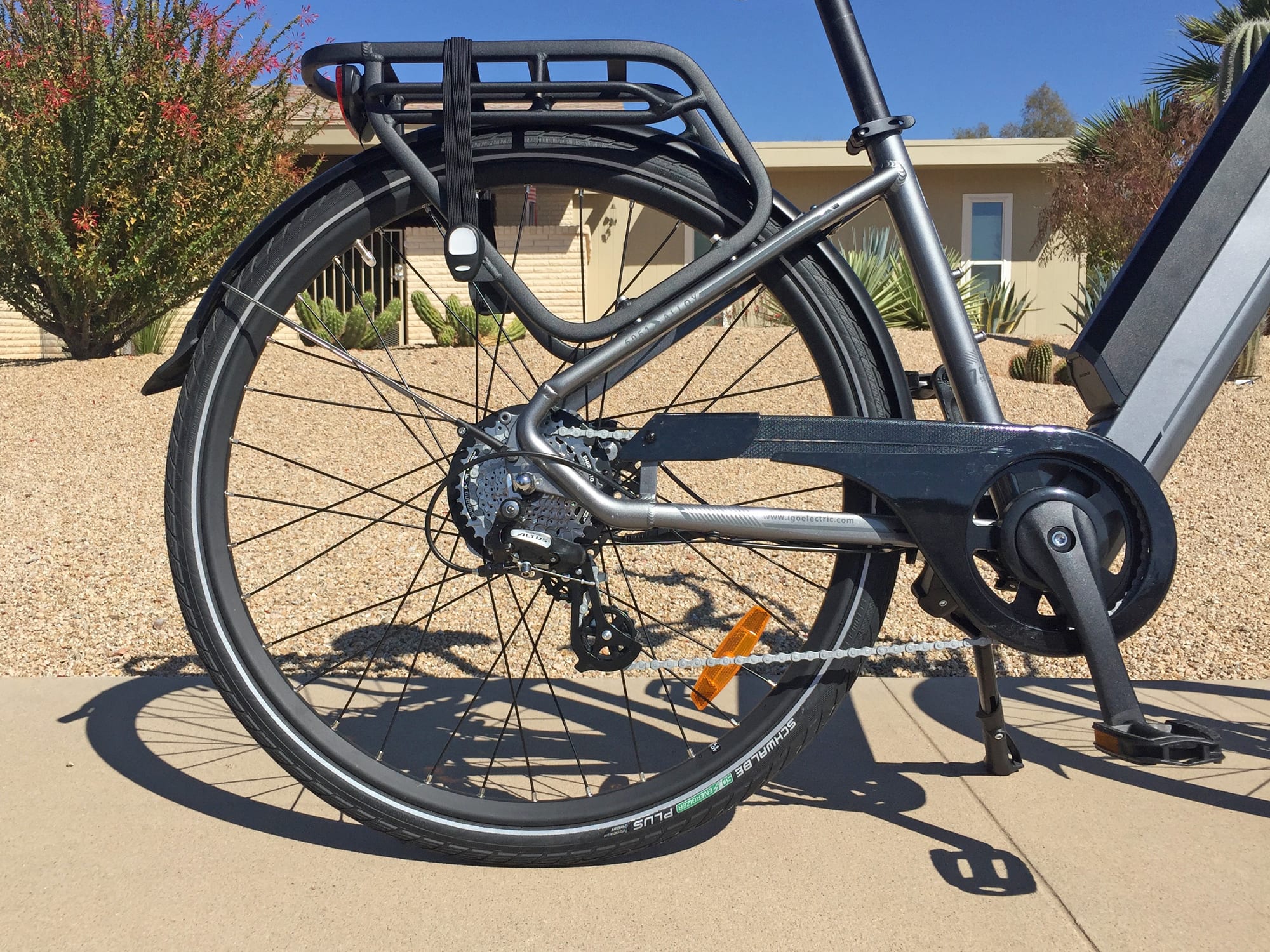
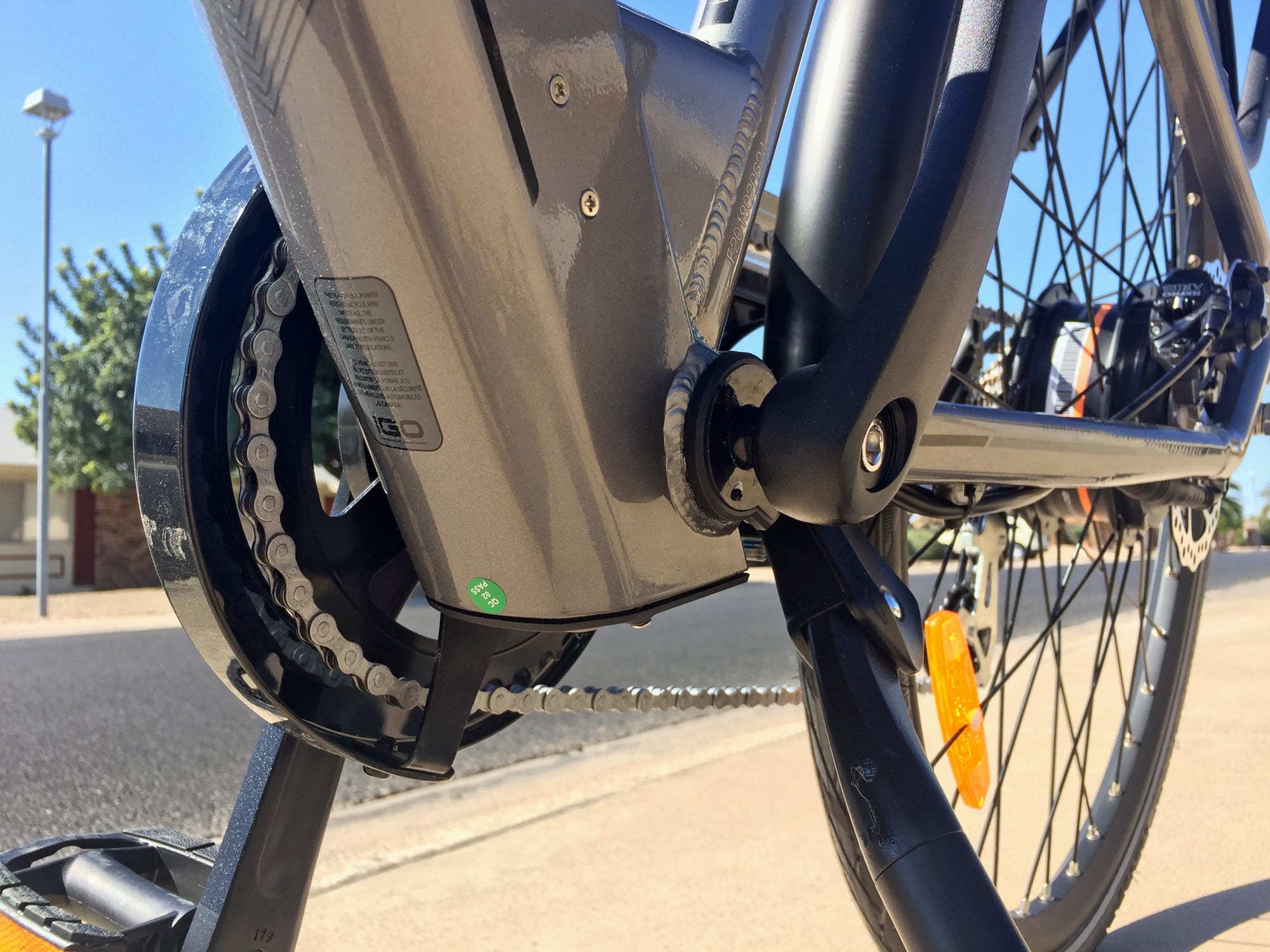
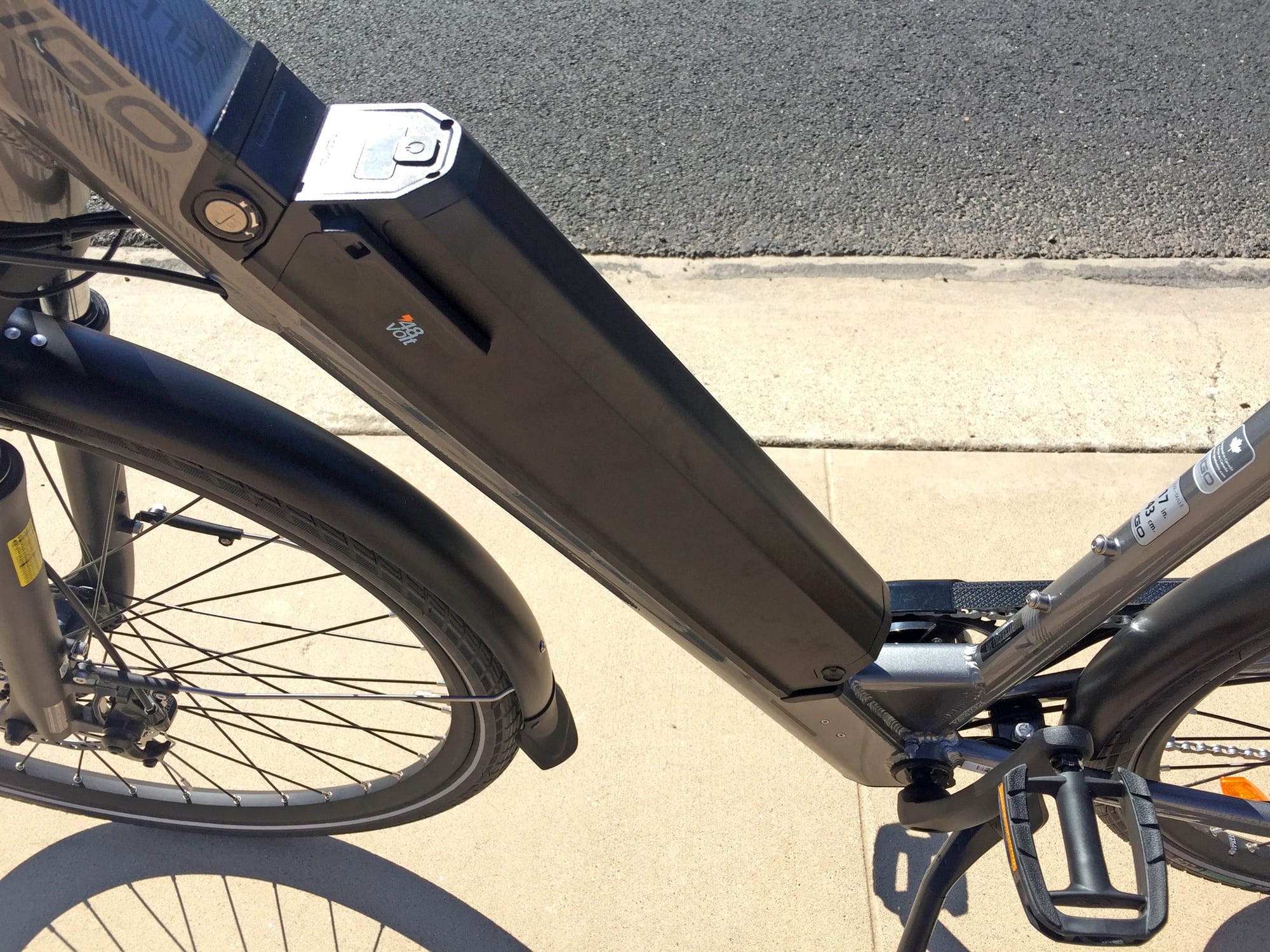

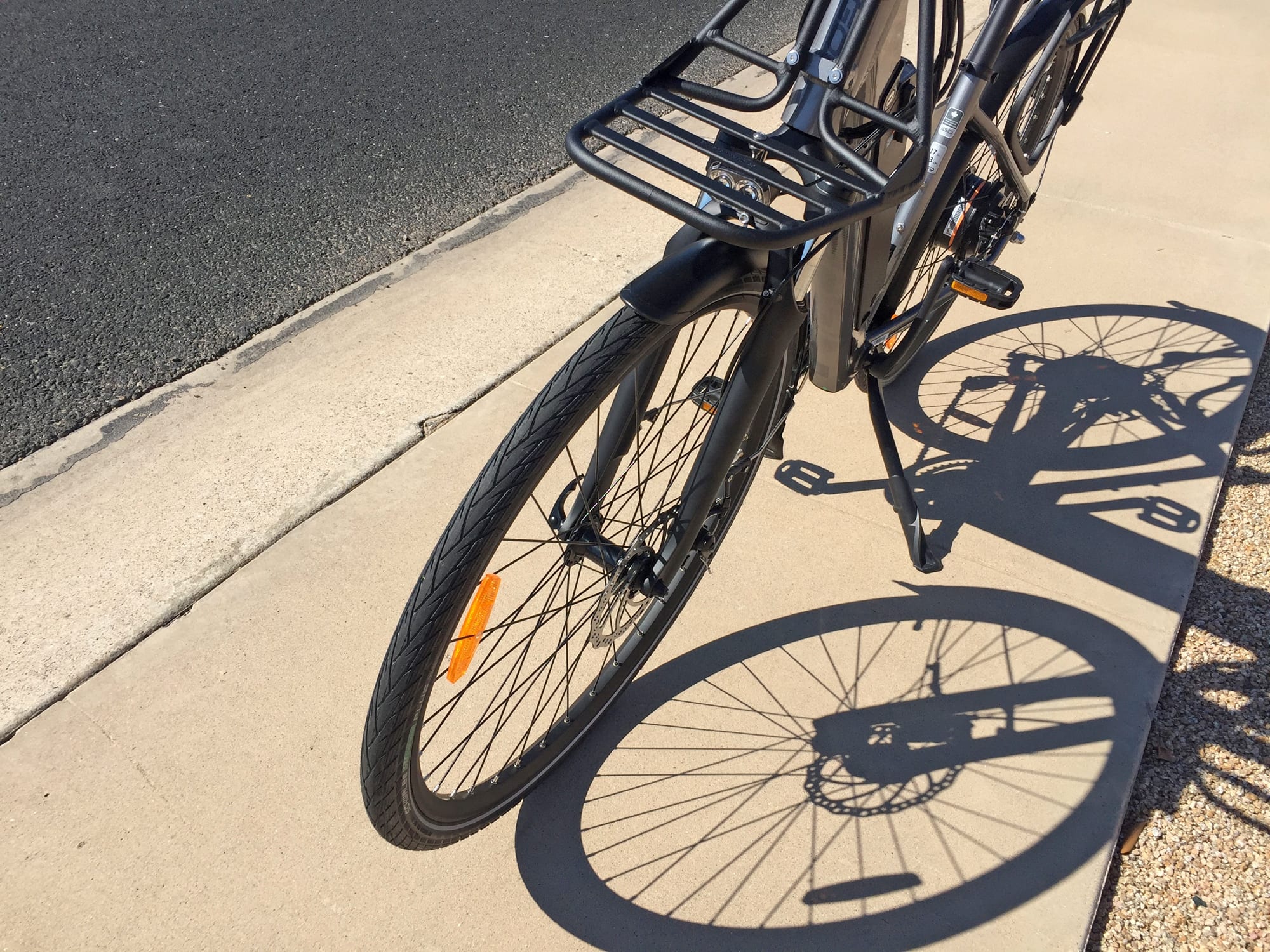
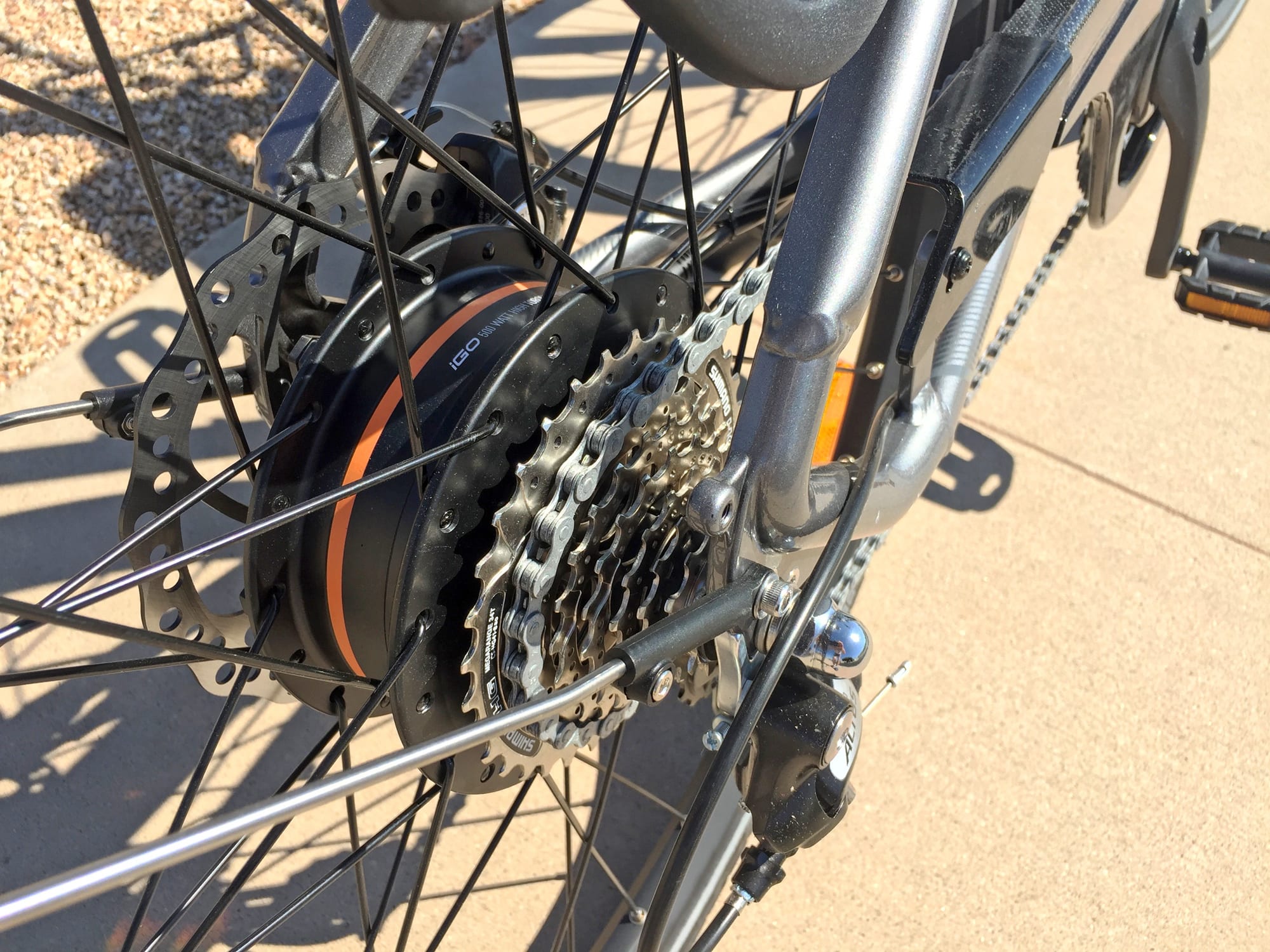

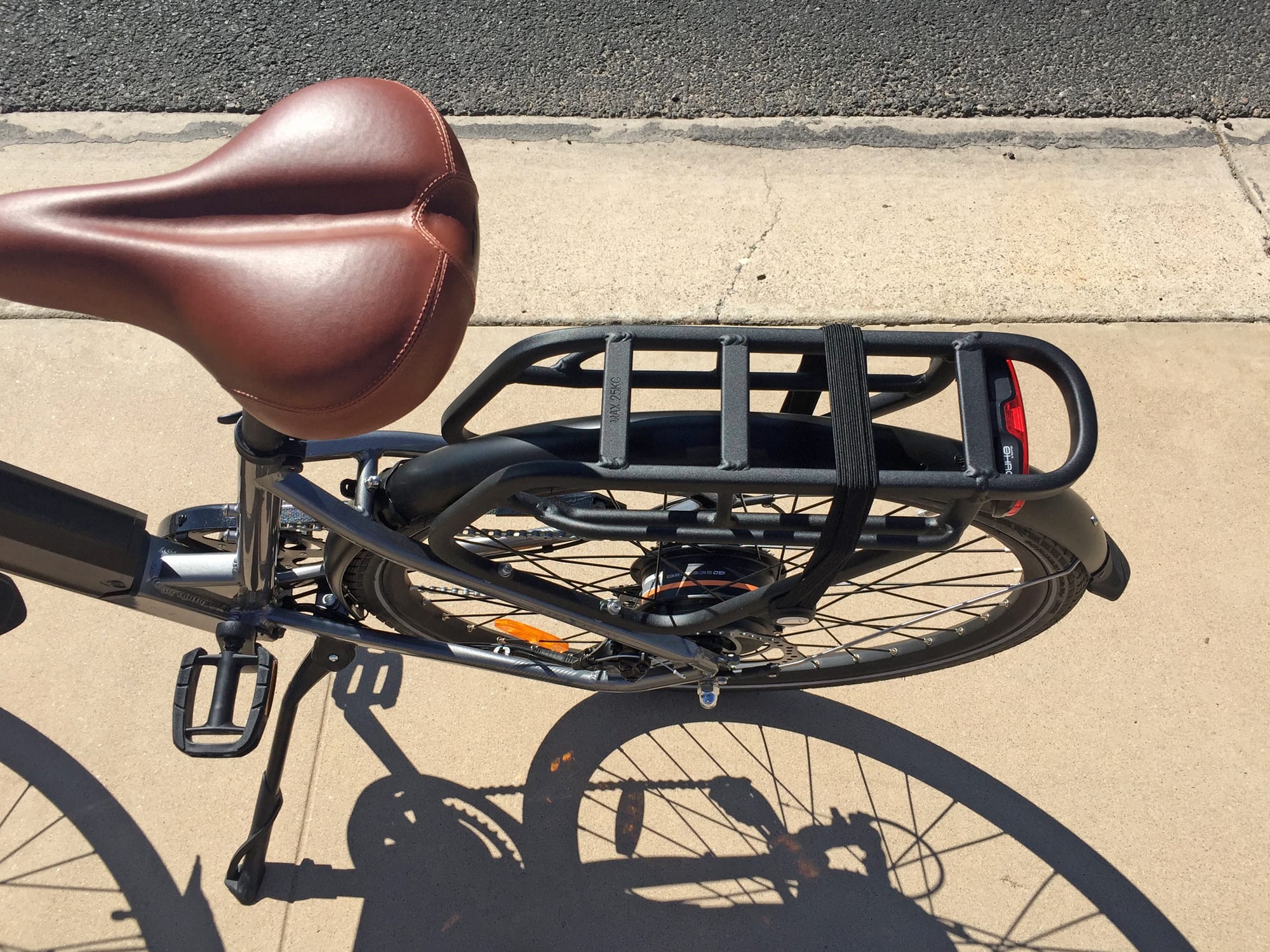
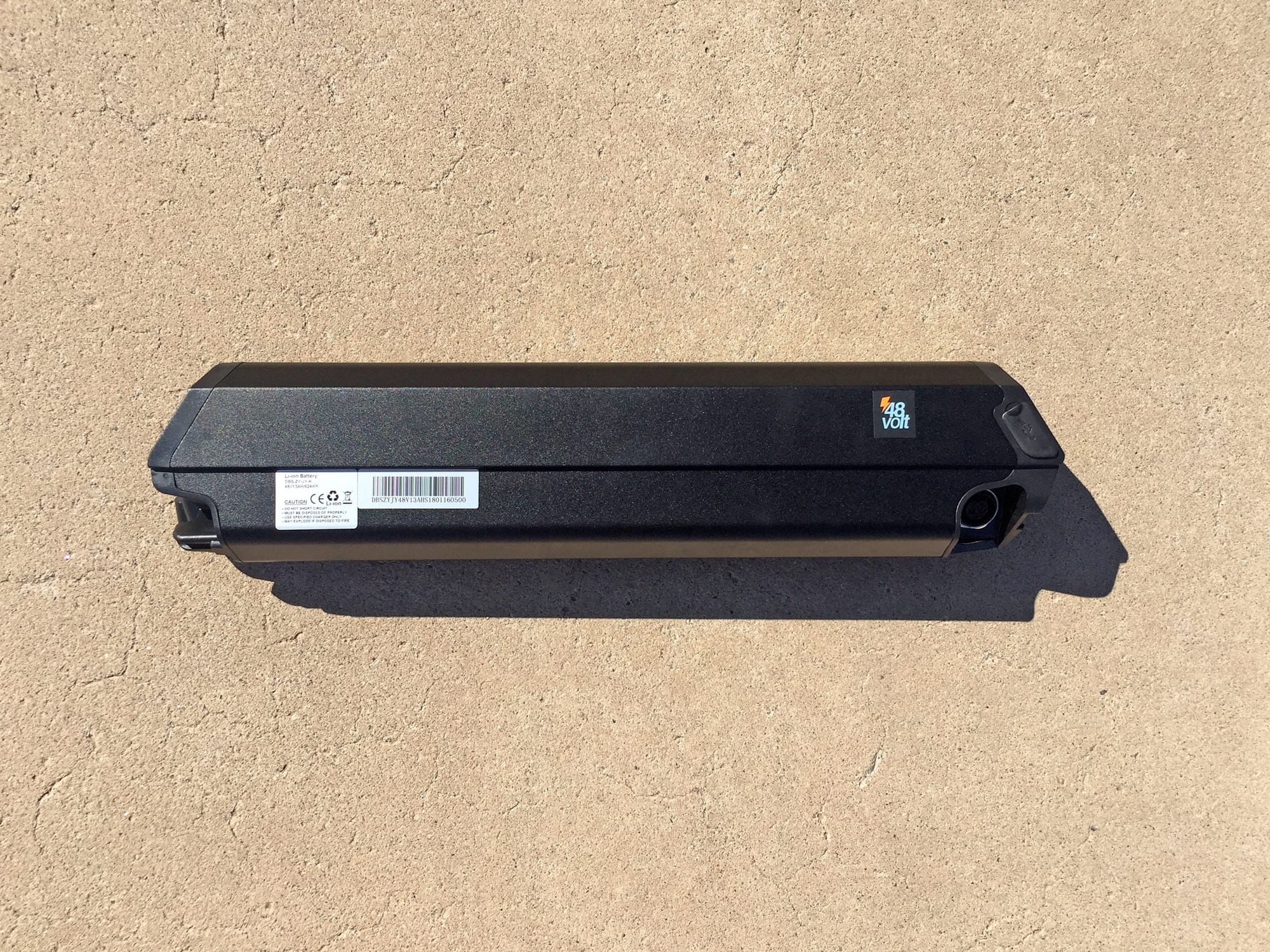
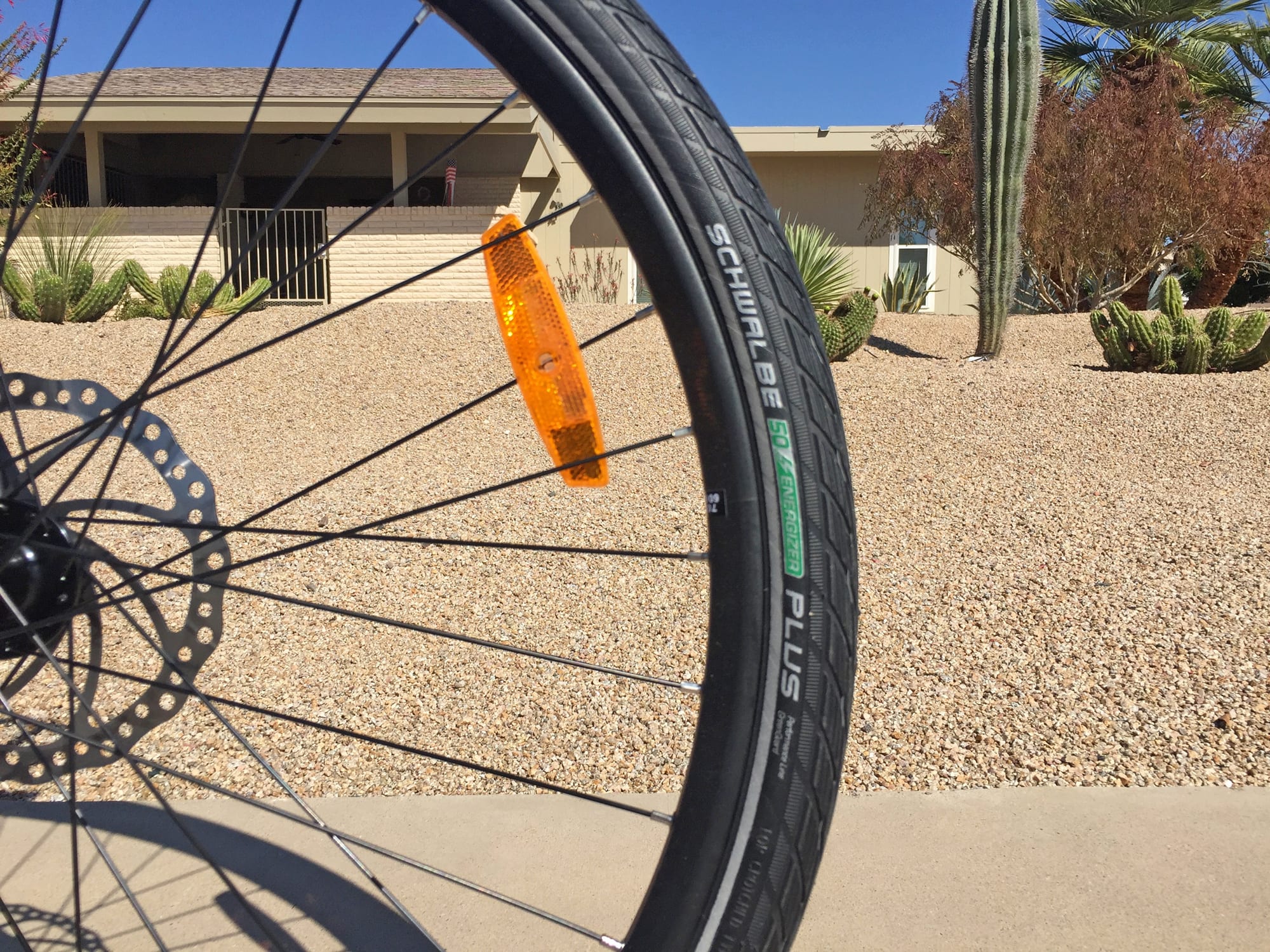
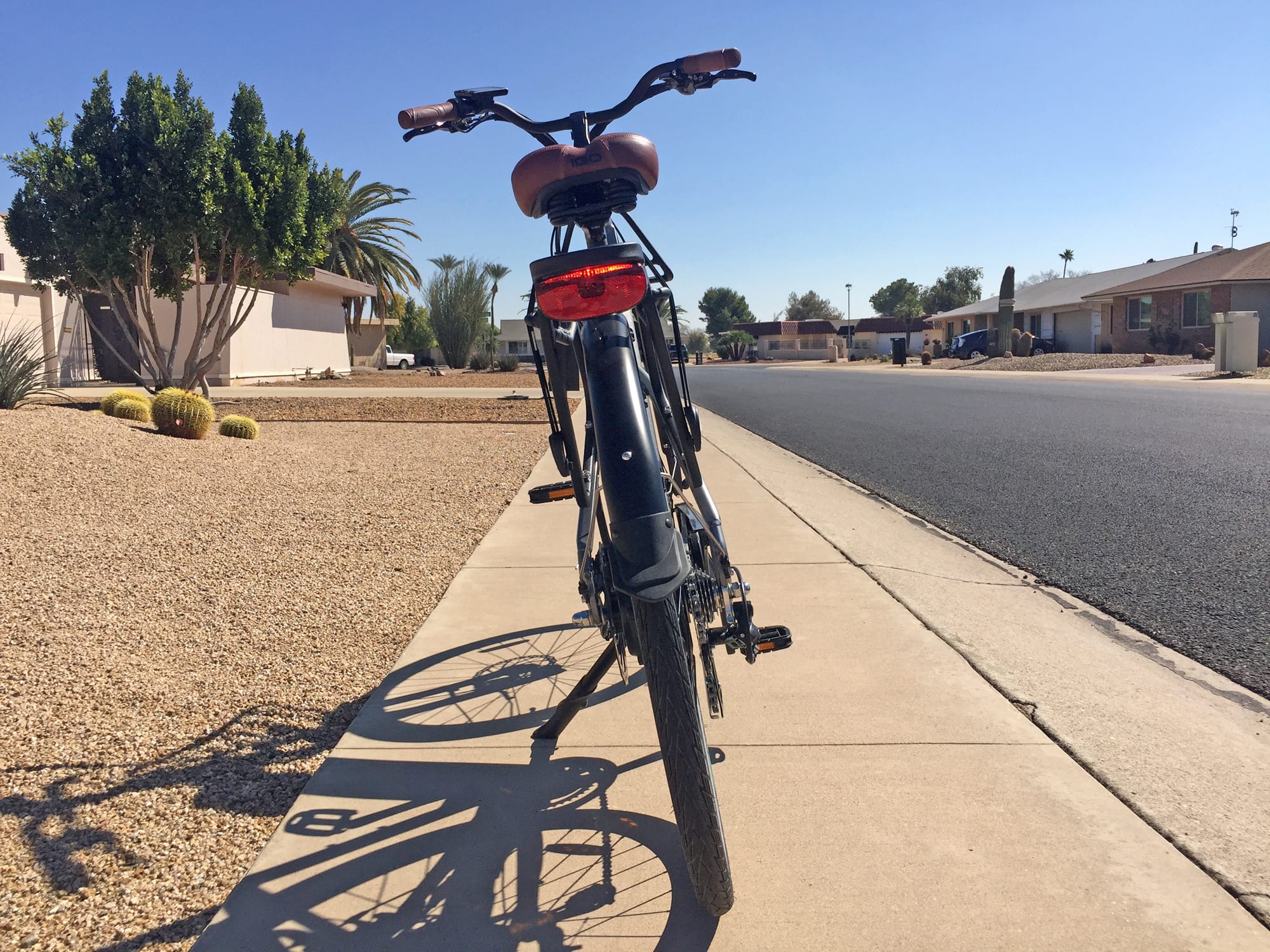
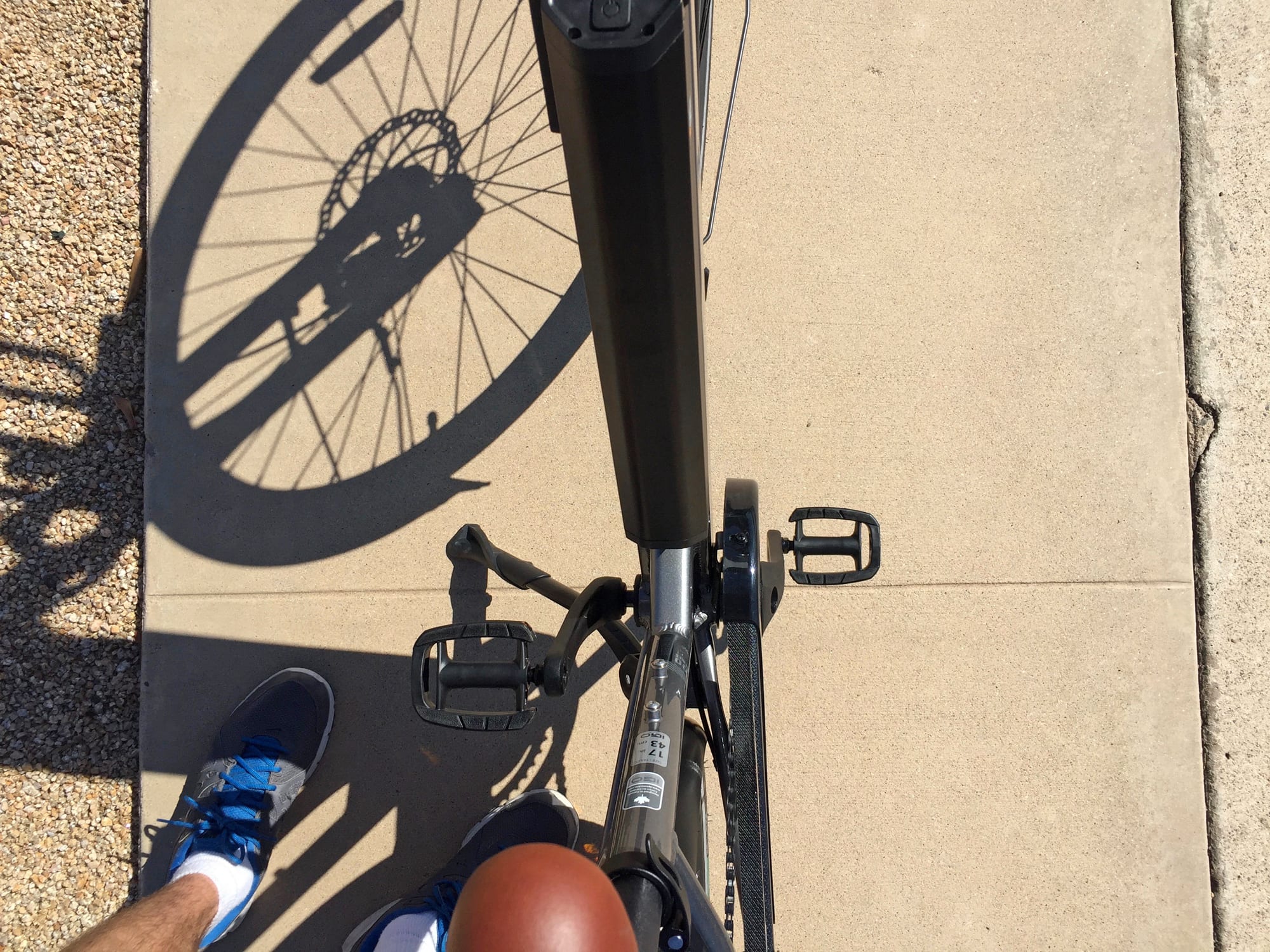
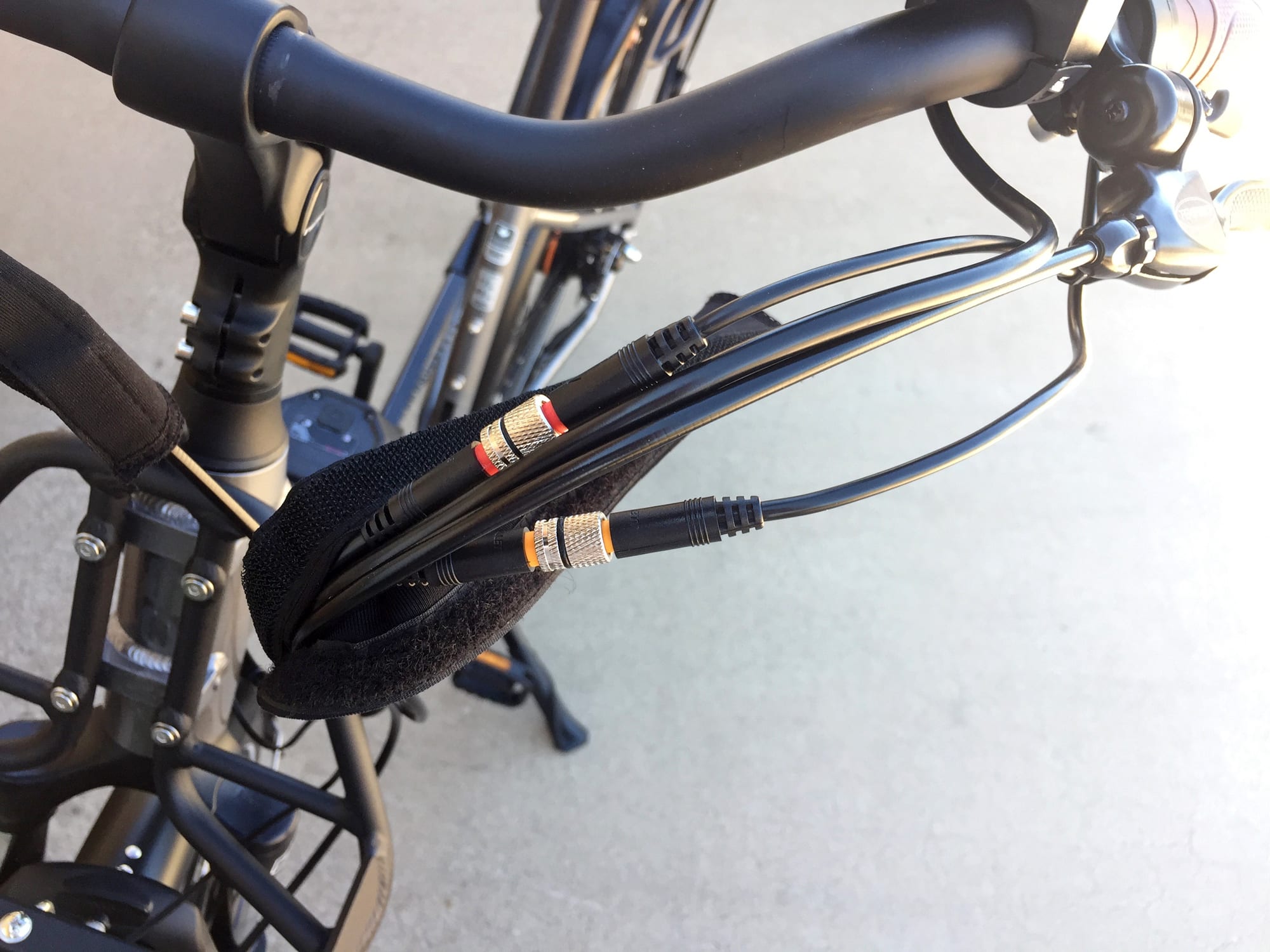
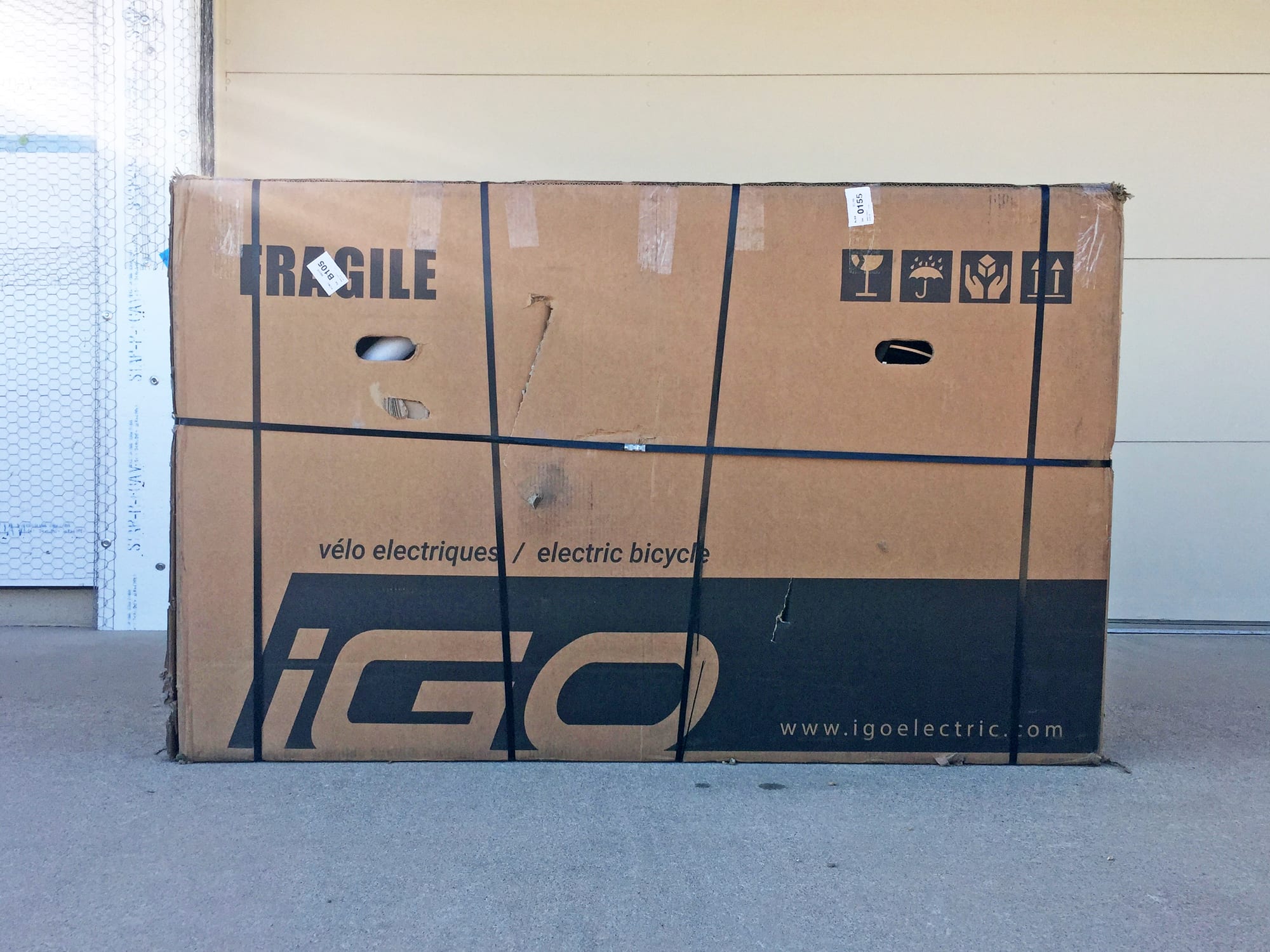
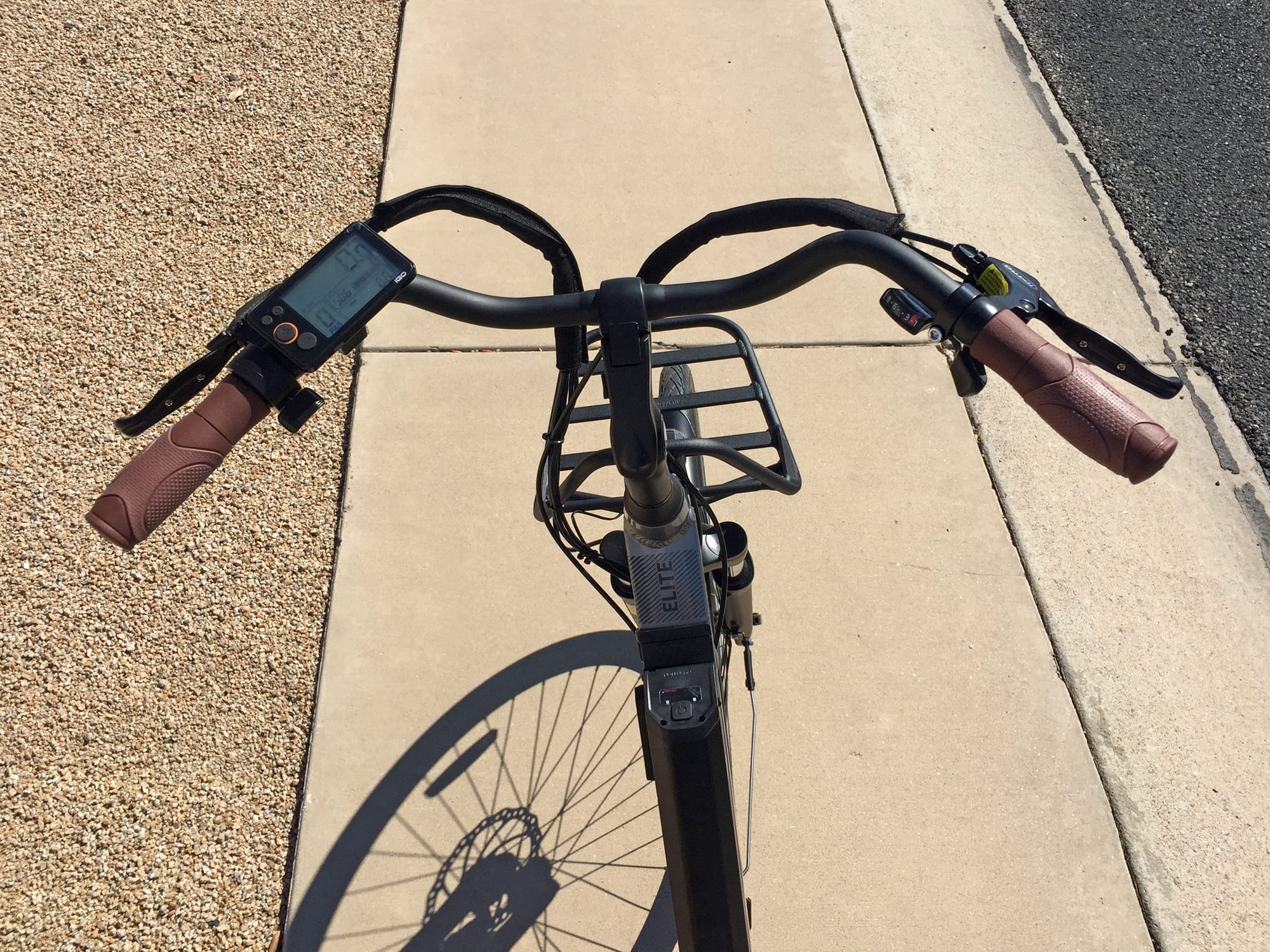
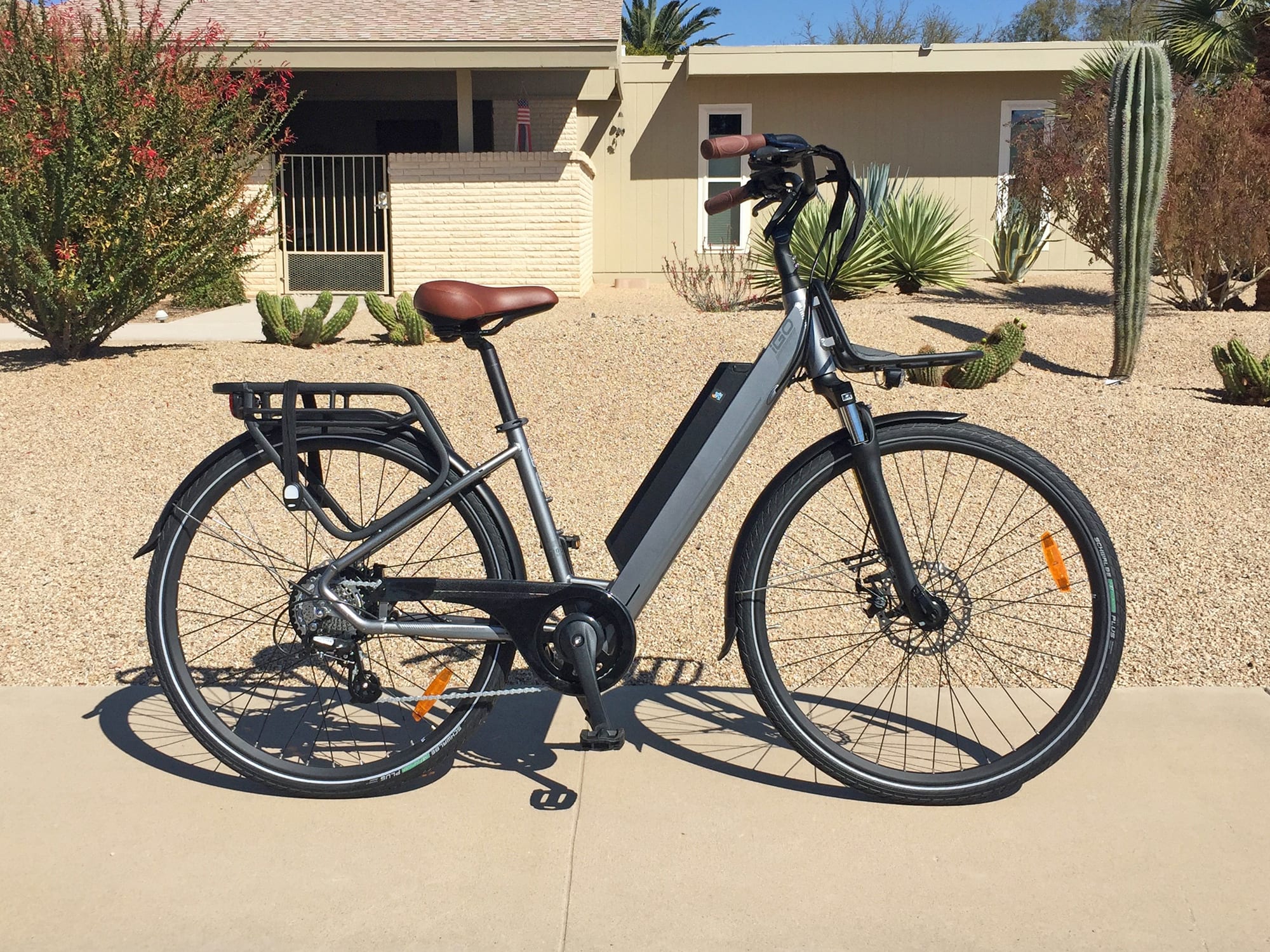

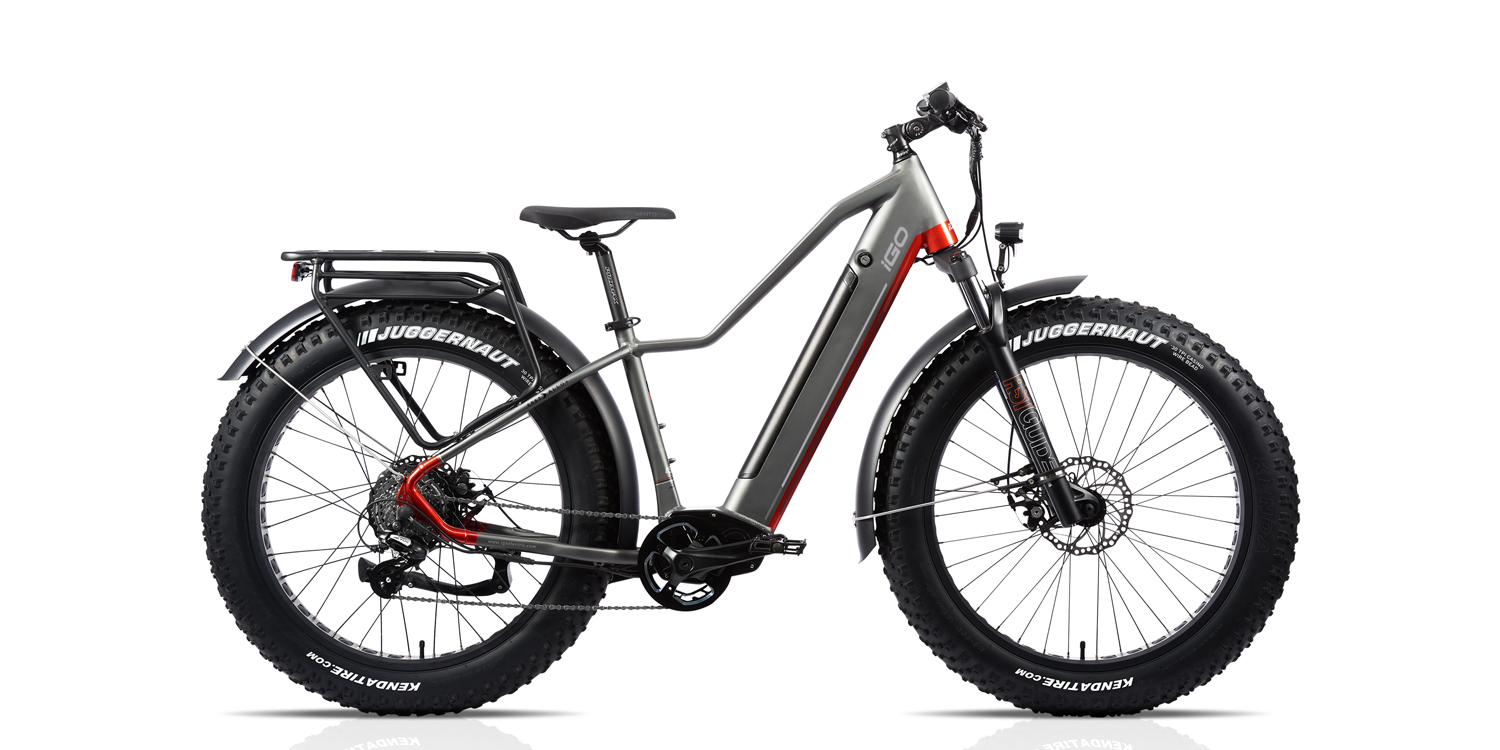
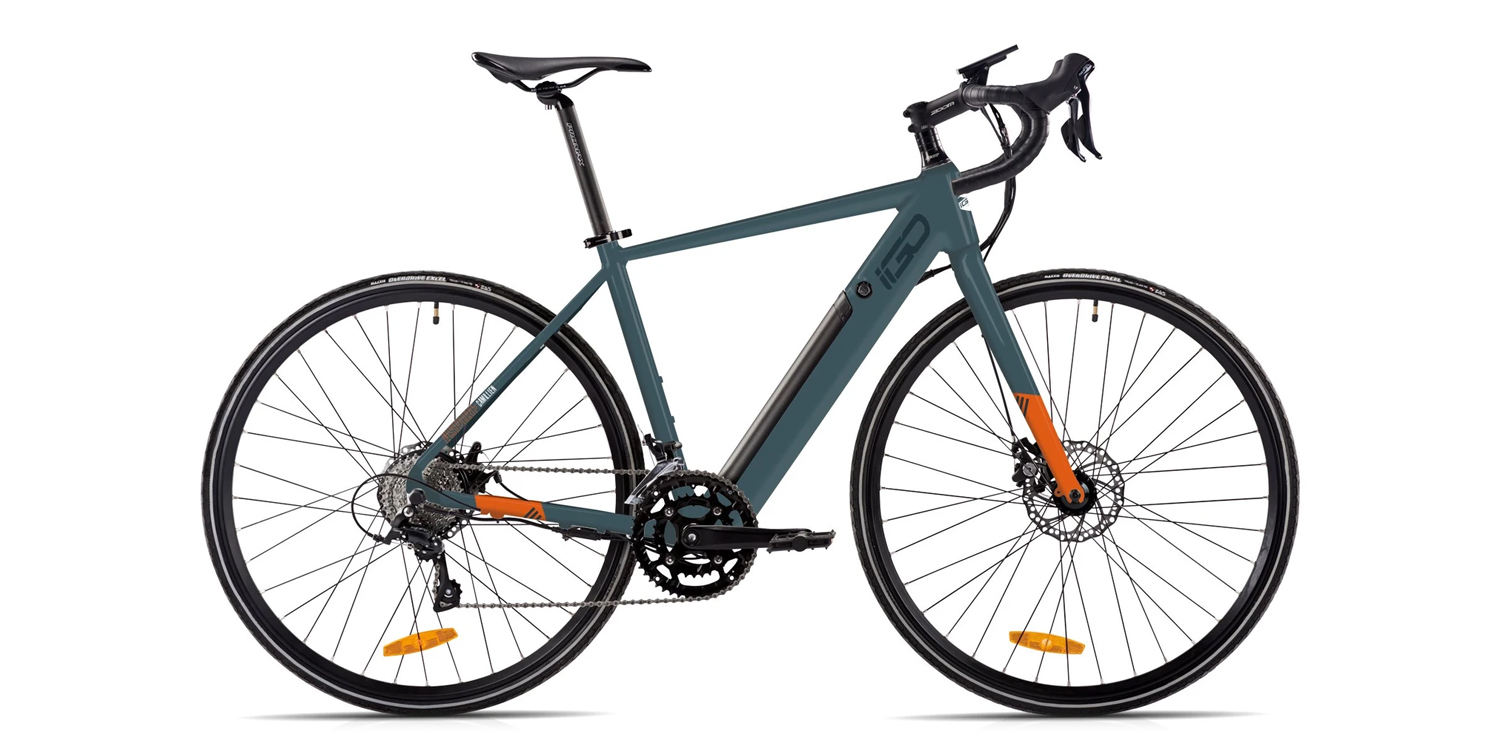
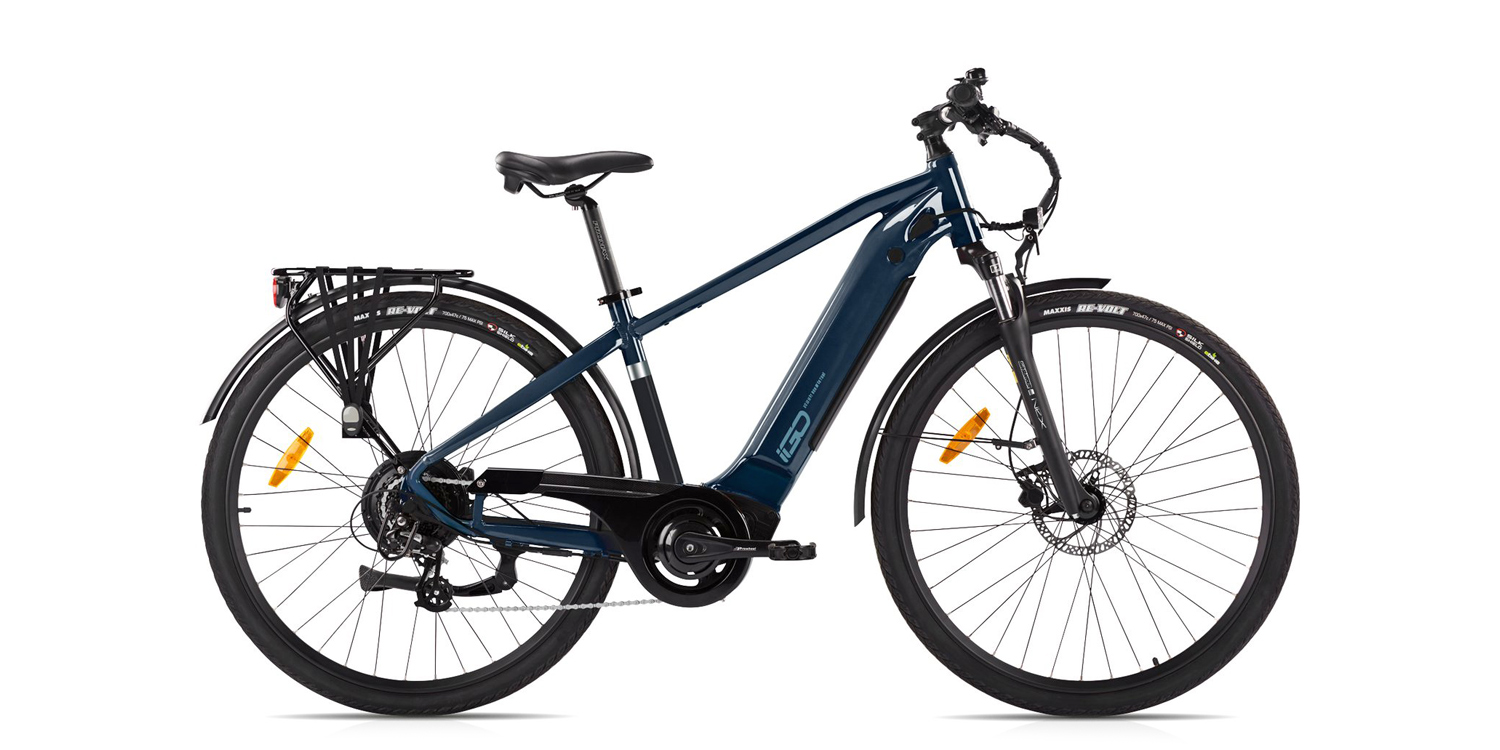
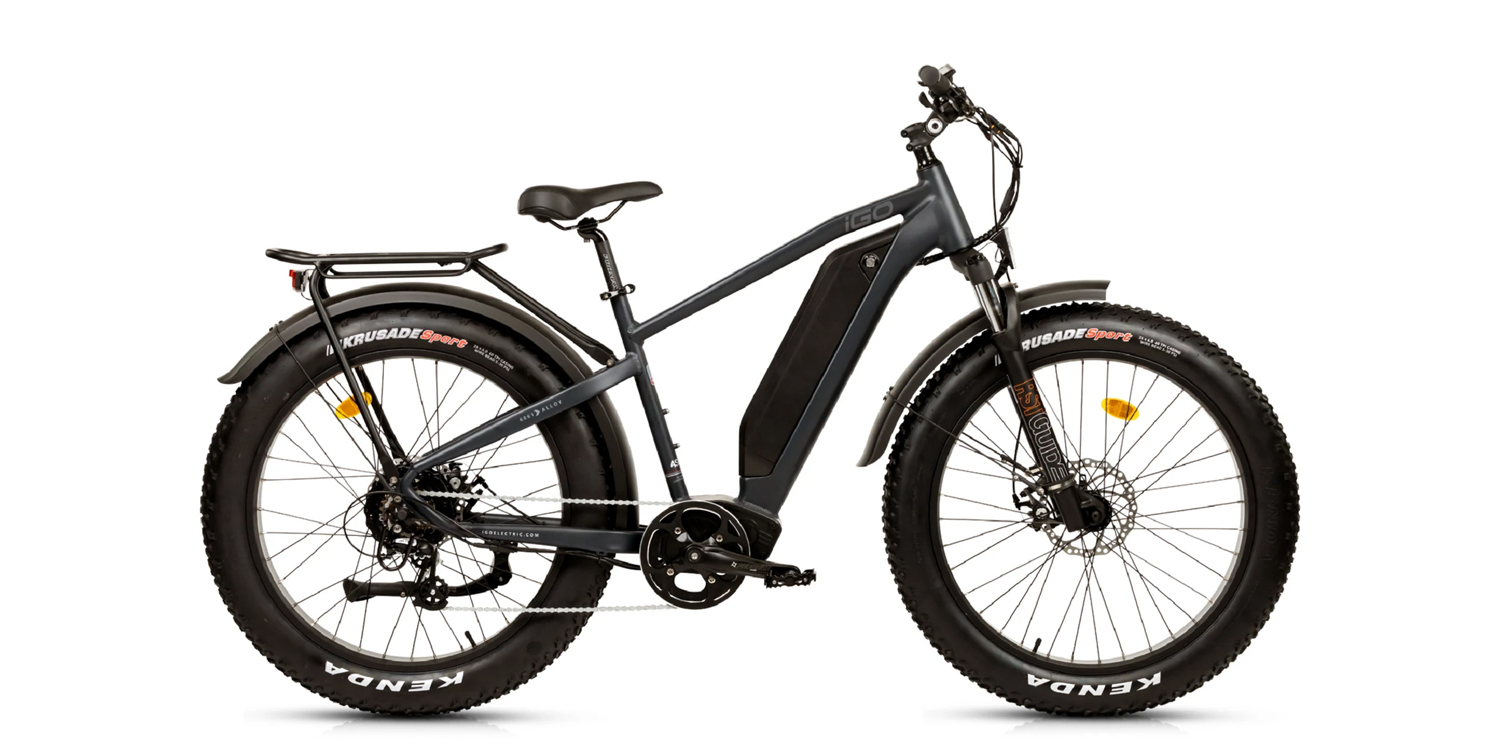

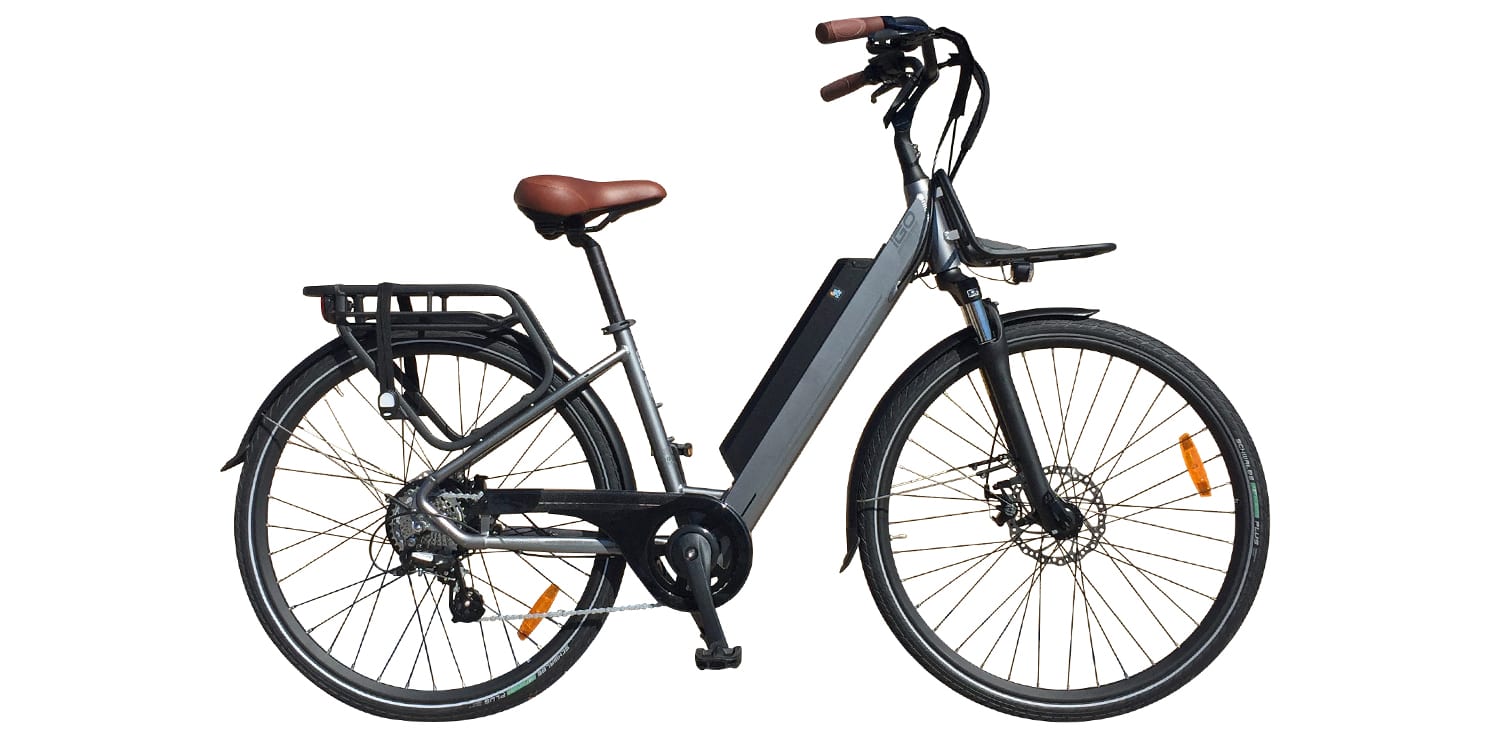
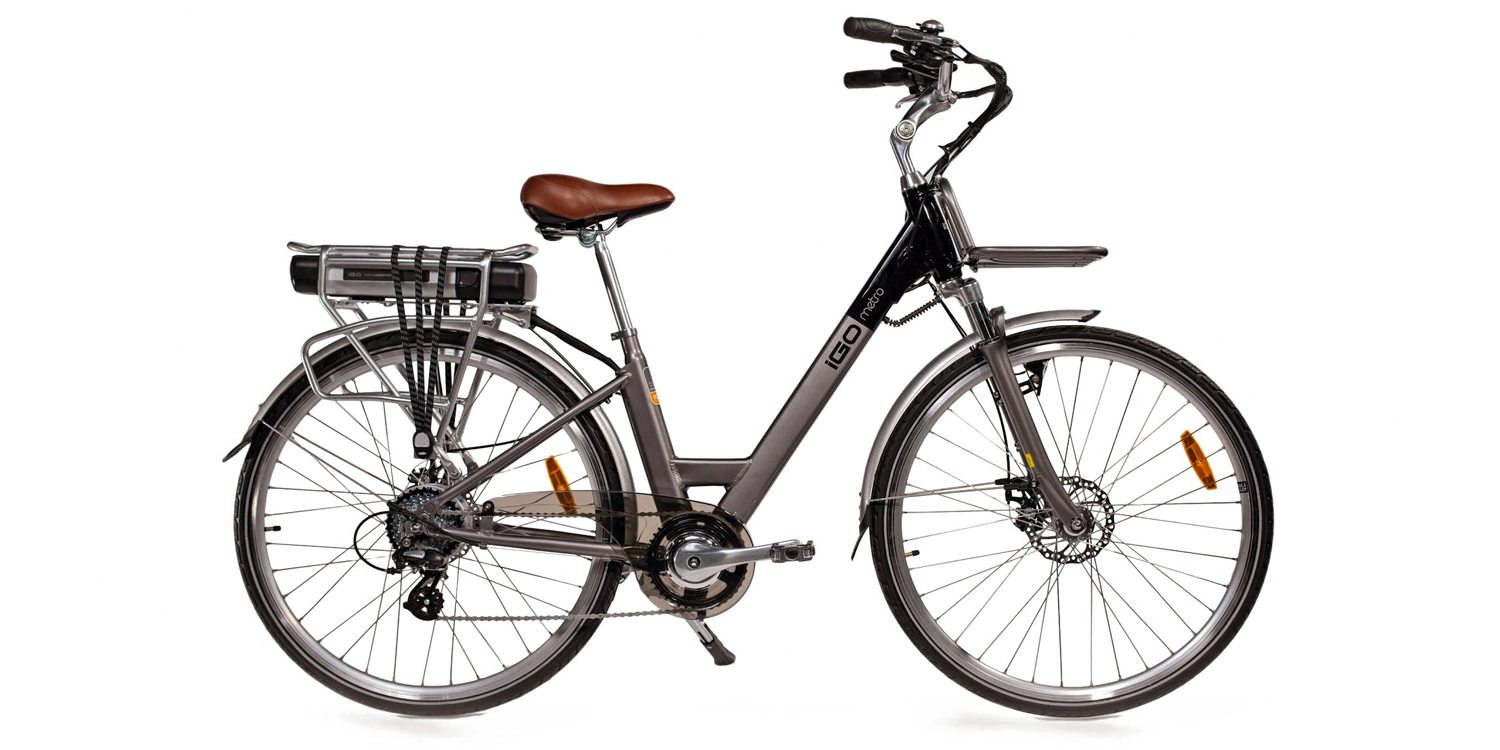
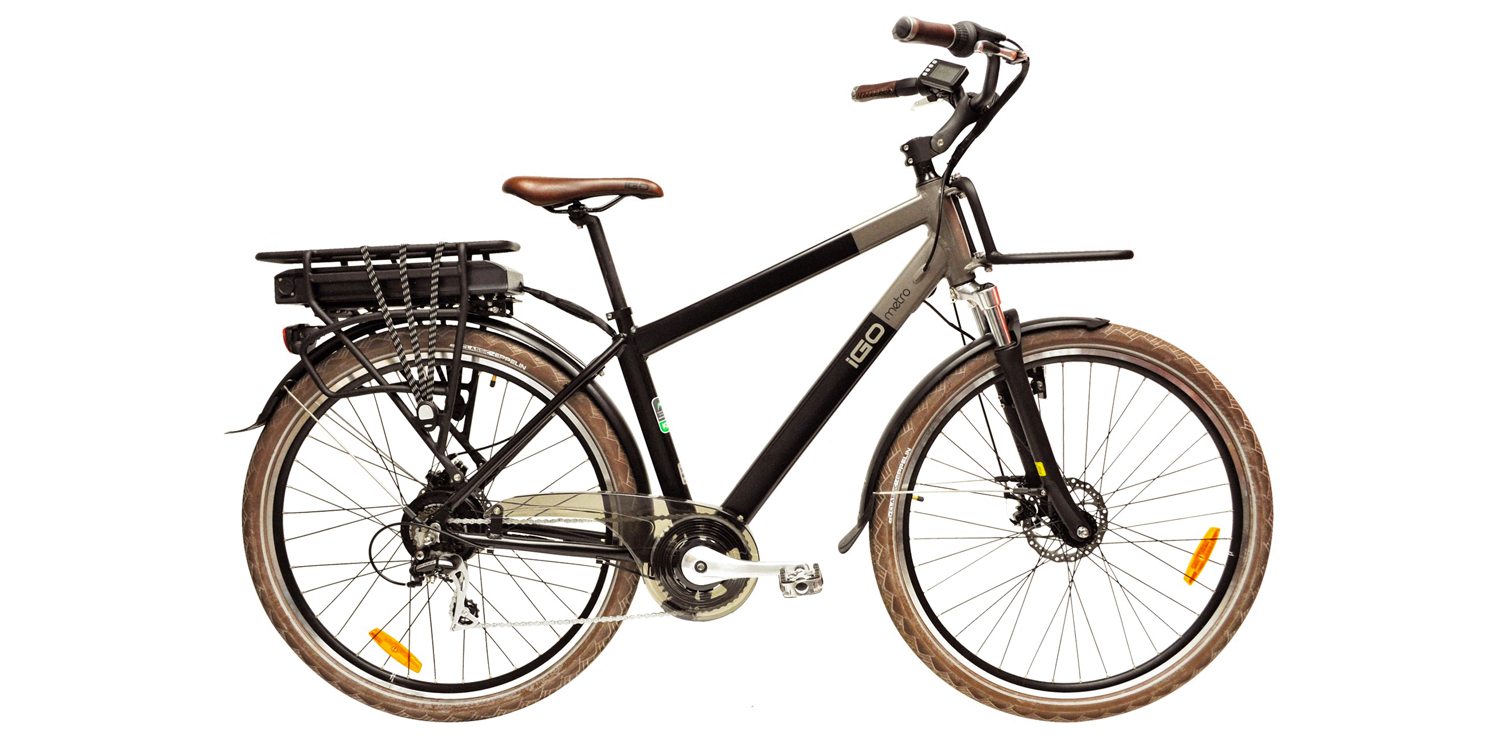
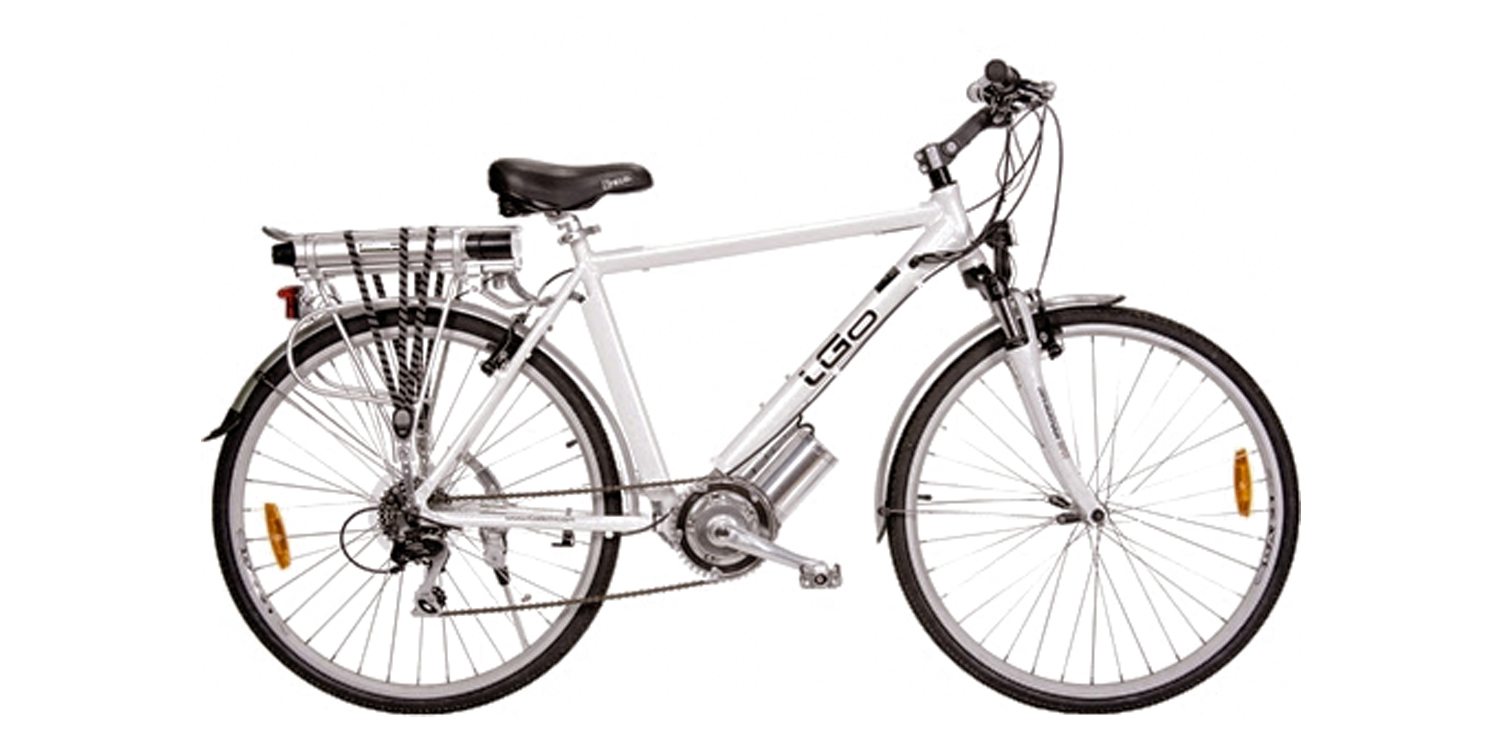

Sue says
Hello, I am planning a bike trip, about 1800km through eastern Canada and the US, I am not a seasoned bike rider and was therefor looking for an electric bike to help me with this. I read these reviews and I am a bit torn between the IGo elite and the Volt bike elegant. Of course the Elite has some nice features and sounds good, but thinking about the price point too, I could get a second batterie for the Elegant and think that might be an asset?! and not be over the price for the Elite. I don’t know if I need the features the Elite gives me and since I can not test drive any of them beforehand, I am a bit torn here.
There are no dealers nearby and I have never driven an electric bike before so I would appreciate some input. One more thing to mention is that I will not leave from home but will have to jump right in and leave from Ontario to go back home with the bike… so there will not be much chance of preparation up front except my bike rides with a regular bike around here. I would appreciate advice and input a lot! Thank you
court says
Hi Sue! Sounds like an amazing adventure :D
I would definitely go with the iGO Elite in your case, because it has reflective tires with puncture protection and the frame is also brighter. The bottle cage bosses could make reaching your drink much easier, and I think the bike just has more features and is better built. Yes, it’s more expensive, but it also comes with a higher capacity battery pack than the VoltBike.
If you have any money leftover, I would also highly recommend the Satori Harmony seat post suspension. It’s only ~$30 on Amazon here and you can get the 30.9 mm diameter to fit this bike. It will make a big difference on your long trip. I hope this advice helps, both bikes offer a lot of value and whatever you choose I’d love to hear back in the comments or maybe see some pictures and feedback in the iGO Forums or VoltBike Forums to help guide other people about what worked and what didn’t. I do think that the iGO will have more assembly required when you get it, so make sure you have a couple of hours and a bike pump to get it done right (and maybe some of your own Allen keys as mentioned in the video).
Sue says
Hi Court, Thanks for the quick response! Can you give me a rough range per charge of battery for either of the bikes? I am planning on going between 60 to 80 km per day for the start and some terrain is a bit hillier. Thanks
court says
Hi Sue! That equates to roughly 50 miles and is at the higher end of range… but achievable if you use the lower second or third levels of assist and pedal regularly. If you do run out, an hour worth of charging will get you around 60% full and you can continue. In my experience, many places that serve drinks or food will let you bring the battery in and charge if you purchase something. It’s difficult to make any real guesses, but I’d still probably go for the single high capacity battery on the iGO and use the rack for other gear. These batteries are sort of long and awkward to stuff into bags, and they are also delicate and expensive… with just one pack and some personal adjustments to how you ride and charging when you stop for lunch, you should do pretty well! The alternative would be to spend a bit more on a mid-drive system from Yamaha, get a Haibike like the Trekking 4.0 which is $2,500 and much more efficient than a hub motor. I will be reviewing that one shortly but can tell you that it’s a great bike with excellent dealer support and a more efficient drive system than iGO, VoltBike or any of the other geared hub setups.
Greg says
Just wondering if the Satori Harmony would allow me to get the seat a bit higher as I am taller, or would it be the same length as the post that comes with the bike? Also, just to confirm that the 30.9mm would fit this bike that is listed with a post diameter of 30.4 mm? Thanks
court says
Hi Greg, it looks like the Satori Harmony comes in a 350 mm length which is just 10 mm longer than the stock post, and I wasn’t able to find it in the narrower 30.4 mm diameter. You probably would not want to get a fatter post than what the seat tube is designed for… but you could get a slimmer post and use shims to make it fit. If you want a suspension post, look for something 400 mm or longer with either 30.4 mm or 27.2 mm (like this, or this) and then use a 27.2 mm to 30.4 mm adapter like this. I hope this helps you! It looks like most of the longer suspension posts cost more money (because they are from higher-end companies), here’s a longer rigid post that would probably fit your bike for cheap.
Ken Morse says
I notice that often the price you quote in your review is way below the price I get when I click on the link for the company. For this Igo, you show a price of $1799 but I see a price of $2399 or $2099 when I go to the website. Do you know why this happens?
court says
Excellent question Ken! I believe the prices that iGO (and some other companies) list is in Canadian or maybe Euros etc. and I always list in USD. If you see a price on EBR that does not match the manufacturer’s website, you can always call them to ask and they will definitely tell me if the price is wrong… and I’ll change it :)
Mike R says
This looks like A LOT OF EBIKE for the money. $1799 is a great price, especially when you consider 2 racks, 13 AH battery capacity, A Grade Samsung cells, 48 volt motor, nice seat, 8 level assist, the Shimano Altus derailleur, and the little details, like the better connectors, wraps, 700c higher end Schwalbe tires, and bottle cage mounts. I over looked this ebike in the past, in part because it wasn’t the most stylish design. The one color may be a little boring, but this ebike is super utilitarian, plenty of power, and looks as comfortable as any other ebike out there in the comfort cruiser range, and priced below $3000. A 2 year warranty as well ! Wow ! How do they do this ?
I’ve seen ebikes priced higher than this with Tourney derailleur, caliper brakes, smaller 36 Volt 10 AH batteries, no racks, no integrated lights, no fenders, no throttle, hard seat, cheaper tires, and no reflective stripes.
And Ive seen and ridden ebikes with all these features priced between $3000 and $4000.
This company appears to be doing everything right, and most importantly, providing greater affordability so more people can get into e-biking without breaking the bank account.
Court says
Agree, I’m excited to review more iGO models next year… they made a bit jump in quality from the old days and this Elite really sets the bar :)